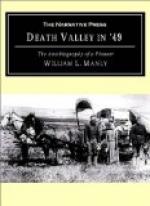As we passed on beyond Scott’s Bluff the game began to be perceptibly scarcer, and what we did find was back from the traveled road, from which it had apparently been driven by the passing hunters.
In time we reached Ft. Laramie, a trading post, where there were some Indian lodges, and we noticed that some of the occupants had lighter complexions than any of the other Indians we had seen. They had cords of dried buffalo meat, and we purchased some. It was very fat, but was so perfectly cured that the clear tallow tasted as sweet as a nut. I thought it was the best dried meat I had ever tasted, but perhaps a good appetite had something to do with it.
As we passed Ft. Laramie we fell in company with some U.S. soldiers who were going to Ft. Hall and thence to Oregon. We considered them pretty safe to travel with and kept with them for some time, though their rate of travel was less than ours. Among them were some Mormons, employed as teamsters, and in other ways, and they told us there were some Missourians on the road who would never live to see California. There had been some contests between the Missourians and the Mormons, and I felt rather glad that none of us hailed from Pike county.
We turned into what they called the Black Hills, leaving the Platte to the north of us. The first night on this road we had the hardest rain I ever experienced, and the only one of any account on our journey. Our camp was on a level piece of ground on the bank of a dry creek, which soon became a very wet creek indeed, for by morning it was one hundred yards wide and absolutely impassible. It went down, however, as quickly as it rose, and by ten o’clock it was so low that we easily crossed and went on our way. We crossed one stream where there were great drifts or piles of hail which had been brought down by a heavy storm from higher up the hills. At one place we found some rounded boulders from six to eight inches in diameter, which were partly hollow, and broken open were found to contain most beautiful crystals of quartz, clear as purest ice. The inside was certainly very pretty, and it was a mystery how it came there. I have since learned that such stones are found at many points, and that they are called geodes.
We came out at the river again at the mouth of Deer Creek, and as there was some pretty good coal there quite easy to get, we made camp one day to try to tighten our wagon tires, John Rogers acting as blacksmith. This was my first chance to reconnoiter, and so I took my gun and went up the creek, a wide, treeless bottom. In the ravines on the south side were beautiful groves of small fir trees and some thick brush, wild rose bushes I think. I found here a good many heads and horns of elk, and I could not decide whether they had been killed in winter during the deep snow, or had starved to death.




